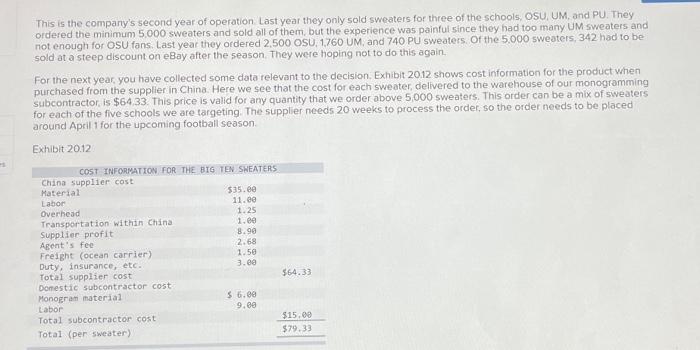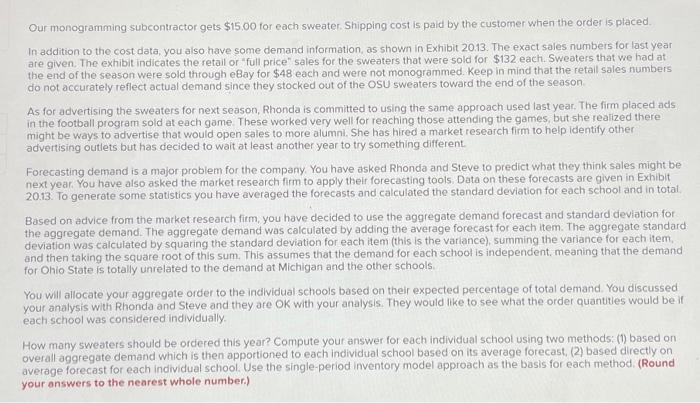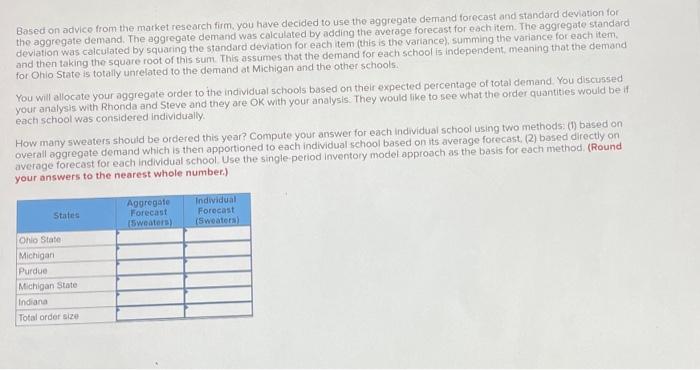This is the company's second year of operation Last year they only sold sweaters for three of the schools, OSU, UM, and PU. They ordered the minimum 5.000 sweaters and sold all of them, but the experience was painful since they had too many UM sweaters and not enough for OSU fans. Last year they ordered 2,500 OSU, 1.760 UM, and 740 PU sweaters of the 5.000 sweaters, 342 had to be sold at a steep discount on eBay after the season. They were hoping not to do this again. For the next year, you have collected some data relevant to the decision. Exhibit 2012 shows cost information for the product when purchased from the supplier in China. Here we see that the cost for each sweater delivered to the warehouse of our monogramming subcontractor, is $64,33. This price is valid for any quantity that we order above 5,000 sweaters. This order can be a mix of sweaters for each of the five schools we are targeting. The supplier needs 20 weeks to process the order, so the order needs to be placed around April 1 for the upcoming football season Exhibit 20.12 COST INFORMATION FOR THE BIG TEN SWEATERS China supplier cost Material 535.ee Labor 11.00 Overhead 1.25 Transportation within China 1.ee Supplier profit 8.90 Agent's fee 2.68 Freight (ocean carrier) 1.50 Duty, insurance, etc. 3.00 Total supplier cost $64.33 Domestic subcontractor cost Monogram material $ 6.80 Labor 9.00 Total subcontractor cost $15.00 Total (per sweater) $79.33 Exhibit 2013 STANDARD DEVIATION 271 AVERAGE FORECAST 2,570 1,733 1,023 1,527 51 242 72 91 93 FORECAST DAYA FOR THE BIG TEN SWEATERS MARKET AVERAGE LAST YEAR'S RHONDA'S RESEARCH FOOTBALL GAME ACTUAL SALES FORECAST FOR STEVE'S FORECAST FORECAST FOR ATTENDANCE (FULL PRICE) NEXT YEAR FOR NEXT YEAR NEXT YEAR 105,261 2,500 2.450 2,380 2,880 188,933 1,468 1,700 1,510 1,990 50,457 690 1,070 940 1,060 74,741 1.680 1,510 1.540 41,833 600 530 107,005 30,109 70,214 59,545 50.05 24, 190 85,071 7,500 5,870 7.890 Ohio State Michigan Purdue Michigan State Indiana Penn State Wisconsin Towa Illinois Minnesota Northwestern Nebraska Total 420 7,420 392 342 sweaters were sold through eBay for $48 each (the customer pays shipping on all orders) N **Calculated assuming the demand at each school is independent Our monogramming subcontractor gets $15.00 for each sweater Shipping cost is paid by the customer when the order is placed In addition to the cost data, you also have some demand information, as shown in Exhibit 20.13. The exact sales numbers for last year are given. The exhibit indicates the retail or "full price sales for the sweaters that were sold for $132 each. Sweaters that we had at the end of the season were sold through eBay for $48 each and were not monogrammed. Keep in mind that the retail sales numbers do not accurately reflect actual demand since they stocked out of the OSU sweaters toward the end of the season As for advertising the sweaters for next season, Rhonda is committed to using the same approach used last year. The firm placed ads in the football program sold at each game. These worked very well for reaching those attending the games, but she realized there might be ways to advertise that would open sales to more alumni. She has hired a market research firm to help identify other advertising outlets but has decided to wait at least another year to try something different Forecasting demand is a major problem for the company. You have asked Rhonda and Steve to predict what they think sales might be next year. You have also asked the market research firm to apply their forecasting tools. Data on these forecasts are given in Exhibit 20.13. To generate some statistics you have averaged the forecasts and calculated the standard deviation for each school and in total Based on advice from the market research firm, you have decided to use the aggregate demand forecast and standard deviation for the aggregate demand. The aggregate demand was calculated by adding the average forecast for each item. The aggregate standard deviation was calculated by squaring the standard deviation for each item (this is the variance), summing the variance for each item, and then taking the square root of this sum. This assumes that the demand for each school is independent, meaning that the demand for Ohio State is totally unrelated to the demand at Michigan and the other schools You will allocate your aggregate order to the individual schools based on their expected percentage of total demand. You discussed your analysis with Rhonda and Steve and they are ok with your analysis. They would like to see what the order quantities would be each school was considered individually. How many sweaters should be ordered this year? Compute your answer for each individual school using two methods: (1) based on overall aggregate demand which is then apportioned to each individual school based on its average forecast, (2) based directly on average forecast for each individual school. Use the single period inventory model approach as the basis for each method (Round your answers to the nearest whole number.) Based on advice from the market research firm, you have decided to use the aggregate demand forecast and standard deviation for the aggregate demand. The aggregate demand was calculated by adding the average forecast for each item. The aggregate standard deviation was calculated by squaring the standard deviation for each item (this is the variance), summing the variance for each item and then taking the square root of this sum. This assumes that the demand for each school is independent meaning that the demand for Ohio State is totally unrelated to the demand at Michigan and the other schools You will allocate your aggregate order to the individual schools based on their expected percentage of total demand. You discussed your analysis with Rhonda and Steve and they are ok with your analysis. They would like to see what the order quantities would be if each school was considered individually, How many sweaters should be ordered this year? Compute your answer for each individual school using two methods. () based on overall aggregate demand which is then apportioned to each individual school based on its average forecast. (2) based directly on average forecast for each individual school Use the single period inventory model approach as the basis for each method. (Round your answers to the nearest whole number) States Aggregate Forecast 15 weaters) Individual Forecast (Sweaters) Ohio State Michigan Purdue Michigan State Indiana Total order size This is the company's second year of operation Last year they only sold sweaters for three of the schools, OSU, UM, and PU. They ordered the minimum 5.000 sweaters and sold all of them, but the experience was painful since they had too many UM sweaters and not enough for OSU fans. Last year they ordered 2,500 OSU, 1.760 UM, and 740 PU sweaters of the 5.000 sweaters, 342 had to be sold at a steep discount on eBay after the season. They were hoping not to do this again. For the next year, you have collected some data relevant to the decision. Exhibit 2012 shows cost information for the product when purchased from the supplier in China. Here we see that the cost for each sweater delivered to the warehouse of our monogramming subcontractor, is $64,33. This price is valid for any quantity that we order above 5,000 sweaters. This order can be a mix of sweaters for each of the five schools we are targeting. The supplier needs 20 weeks to process the order, so the order needs to be placed around April 1 for the upcoming football season Exhibit 20.12 COST INFORMATION FOR THE BIG TEN SWEATERS China supplier cost Material 535.ee Labor 11.00 Overhead 1.25 Transportation within China 1.ee Supplier profit 8.90 Agent's fee 2.68 Freight (ocean carrier) 1.50 Duty, insurance, etc. 3.00 Total supplier cost $64.33 Domestic subcontractor cost Monogram material $ 6.80 Labor 9.00 Total subcontractor cost $15.00 Total (per sweater) $79.33 Exhibit 2013 STANDARD DEVIATION 271 AVERAGE FORECAST 2,570 1,733 1,023 1,527 51 242 72 91 93 FORECAST DAYA FOR THE BIG TEN SWEATERS MARKET AVERAGE LAST YEAR'S RHONDA'S RESEARCH FOOTBALL GAME ACTUAL SALES FORECAST FOR STEVE'S FORECAST FORECAST FOR ATTENDANCE (FULL PRICE) NEXT YEAR FOR NEXT YEAR NEXT YEAR 105,261 2,500 2.450 2,380 2,880 188,933 1,468 1,700 1,510 1,990 50,457 690 1,070 940 1,060 74,741 1.680 1,510 1.540 41,833 600 530 107,005 30,109 70,214 59,545 50.05 24, 190 85,071 7,500 5,870 7.890 Ohio State Michigan Purdue Michigan State Indiana Penn State Wisconsin Towa Illinois Minnesota Northwestern Nebraska Total 420 7,420 392 342 sweaters were sold through eBay for $48 each (the customer pays shipping on all orders) N **Calculated assuming the demand at each school is independent Our monogramming subcontractor gets $15.00 for each sweater Shipping cost is paid by the customer when the order is placed In addition to the cost data, you also have some demand information, as shown in Exhibit 20.13. The exact sales numbers for last year are given. The exhibit indicates the retail or "full price sales for the sweaters that were sold for $132 each. Sweaters that we had at the end of the season were sold through eBay for $48 each and were not monogrammed. Keep in mind that the retail sales numbers do not accurately reflect actual demand since they stocked out of the OSU sweaters toward the end of the season As for advertising the sweaters for next season, Rhonda is committed to using the same approach used last year. The firm placed ads in the football program sold at each game. These worked very well for reaching those attending the games, but she realized there might be ways to advertise that would open sales to more alumni. She has hired a market research firm to help identify other advertising outlets but has decided to wait at least another year to try something different Forecasting demand is a major problem for the company. You have asked Rhonda and Steve to predict what they think sales might be next year. You have also asked the market research firm to apply their forecasting tools. Data on these forecasts are given in Exhibit 20.13. To generate some statistics you have averaged the forecasts and calculated the standard deviation for each school and in total Based on advice from the market research firm, you have decided to use the aggregate demand forecast and standard deviation for the aggregate demand. The aggregate demand was calculated by adding the average forecast for each item. The aggregate standard deviation was calculated by squaring the standard deviation for each item (this is the variance), summing the variance for each item, and then taking the square root of this sum. This assumes that the demand for each school is independent, meaning that the demand for Ohio State is totally unrelated to the demand at Michigan and the other schools You will allocate your aggregate order to the individual schools based on their expected percentage of total demand. You discussed your analysis with Rhonda and Steve and they are ok with your analysis. They would like to see what the order quantities would be each school was considered individually. How many sweaters should be ordered this year? Compute your answer for each individual school using two methods: (1) based on overall aggregate demand which is then apportioned to each individual school based on its average forecast, (2) based directly on average forecast for each individual school. Use the single period inventory model approach as the basis for each method (Round your answers to the nearest whole number.) Based on advice from the market research firm, you have decided to use the aggregate demand forecast and standard deviation for the aggregate demand. The aggregate demand was calculated by adding the average forecast for each item. The aggregate standard deviation was calculated by squaring the standard deviation for each item (this is the variance), summing the variance for each item and then taking the square root of this sum. This assumes that the demand for each school is independent meaning that the demand for Ohio State is totally unrelated to the demand at Michigan and the other schools You will allocate your aggregate order to the individual schools based on their expected percentage of total demand. You discussed your analysis with Rhonda and Steve and they are ok with your analysis. They would like to see what the order quantities would be if each school was considered individually, How many sweaters should be ordered this year? Compute your answer for each individual school using two methods. () based on overall aggregate demand which is then apportioned to each individual school based on its average forecast. (2) based directly on average forecast for each individual school Use the single period inventory model approach as the basis for each method. (Round your answers to the nearest whole number) States Aggregate Forecast 15 weaters) Individual Forecast (Sweaters) Ohio State Michigan Purdue Michigan State Indiana Total order size










